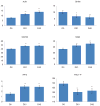Symptoms predicting health-related quality of life in prostate cancer patients treated with localized radiation therapy
- PMID: 30263893
- PMCID: PMC6155995
- DOI: 10.15212/FMCH.2017.0133
Symptoms predicting health-related quality of life in prostate cancer patients treated with localized radiation therapy
Abstract
Objective: Patient-reported health-related quality-of-life (HRQOL) measures can provide guidance for treatment decision making, symptom management, and discharge planning. HRQOL is often influenced by the distress experienced by patients from disease or treatment-related symptoms. This study aimed to identify symptoms that can predict changes in HRQOL in men undergoing external beam radiation therapy (EBRT) for nonmetastatic prostate cancer (NMPC).
Methods: Fifty-one men with NMPC scheduled for EBRT were assessed at the baseline, at the midpoint of EBRT, and at the end of EBRT. All participants received 38-42 daily doses of EBRT (five times a week), depending on the stage of their disease. Validated questionnaires were administered to evaluate depressive symptoms, urinary and sexual functions, bowel issues, symptom-related distress, fatigue, and HRQOL. Pearson correlations, repeated-measures ANOVA, and multiple regressions examined the relationships among variables.
Results: Intensification of symptoms and increased symptom-related distress, with a corresponding decline in HRQOL, were observed during EBRT in men with NMPC. Changes in symptoms and symptom distress were associated with changes in HRQOL at the midpoint of EBRT (r=-0.37 to -0.6, P=0.05) and at the end of EBRT (r=-0.3 to -0.47, P=0.01) compared with the baseline. The regression model comprising age, body mass index, Gleason score, T category, androgen-deprivation therapy use, radiation dose received, symptoms (urinary/sexual/bowel problems, fatigue), and overall symptom distress explained 70% of the variance in predicting HRQOL. Urinary problems and fatigue significantly predicted the decline in HRQOL during EBRT.
Conclusion: Identifying specific symptoms that can influence HRQOL during EBRT for NMPC can provide feasible interventional targets to improve treatment outcomes.
Keywords: Symptoms; health-related quality of life; prostate cancer; radiation therapy; symptom distress.
Conflict of interest statement
Conflict of interest The authors declare that they have no conflict of interest.
Figures


References
-
- Sloan JA, Berk L, Roscoe J, Fisch MJ, Shaw EG, Wyatt G, et al. Integrating patient-reported outcomes into cancer symptom management clinical trials supported by the National Cancer Institute–sponsored Clinical Trials Networks. J Clin Oncol. 2007;25(32):5070–7. - PubMed
-
- Diao K, Lobos EA, Yirmibesoglu E, Basak R, Hendrix LH, Barbosa B, et al. Patient-reported quality of life during definitive and postprostatectomy image-guided radiation therapy for prostate cance. Pract Radiat Oncol. 2017;7(2):e117–24. - PubMed
-
- American Cancer Society. American Cancer Society facts and figures. 2017 [cited 2017 March 10]. Available from: http://www.cancer.org/content/dam/CRC/PDF/Public/8793.00.pdf.
-
- Pinkawa M, Gontero P. The motion: radiotherapy for prostate cancer preserves sexual function to a greater extent than nerve sparing radical prostatectomy. Eur Urol. 2009;56(1):212–4. - PubMed
Grants and funding
LinkOut - more resources
Full Text Sources
Other Literature Sources
